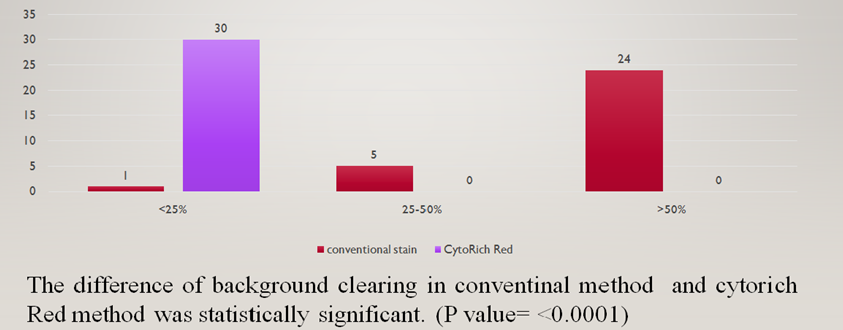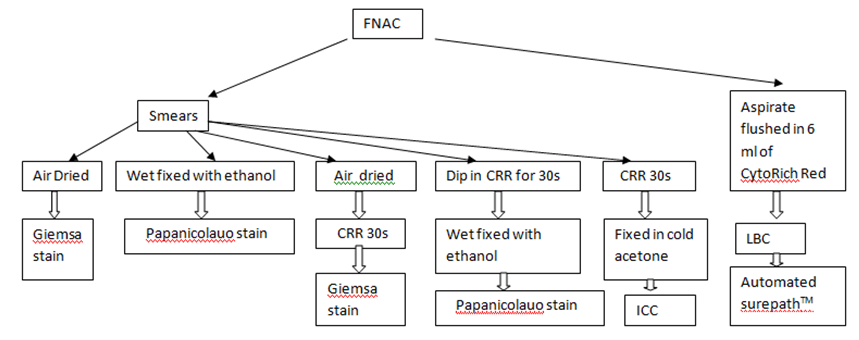Introduction
Fine needle asoiration cytology (FNAC) is a well established cost effective, simple outdoor patient department procedure for investigation of palpable swellings. It is useful for initial triage of benign and malignant cases along with diagnosis of metastatic/recurrent cases and for staging of cancers.1 But the blood accompanying the diagnostic material in FNAC smears dilutes and hinders the material which increases the screening time and makes the interpretation difficult. Preservation and fixation of cells is a critical requirement for correct interpretation of smears. An ideal fixative should preserve the cytomorphological details with little to no distortion of cells and their architecture. The CytoRich Red system was introduced for fixation of cells alongwith lysis of background red blood cells and mucus.3, 2 The effectiveness of CytoRich Red is being studied in non gynaecological fluids and fine needle aspiration smears.4 Other fluids like acetic acid and Devine’s lysing solution are also used for lysis of background red blood cells.
Materials and Methods
Thirty haemorrhagic FNAC smears from various organs were included in the study. The fine needle aspirate was divided into two parts as shown in Figure 1. The cytomorphological features and background was compared in all the slides. The smears were divided into 3 groups depending on percentage of hemorrhage on the smears. that is <25%, 25-50% and >50%. SPSS software version 24 was used for statistical analysis. A P value of ≤ 0.05 was considered as significant.
Results
The thirty cases included 16 breast, eight thyroid, four lymph node and two soft tissue lesions. The cytomorphological features were compared between the conventional smears (CS) and cytoRich Red fixative (CRR) smears (Table 1). The cellularity and nuclear-cytoplasmic features were similar in CS and CRR smears. Whereas in comparision to CS and CRR smears LBC smears had low cellularity with loss of cellular architecture, there was false increase in nuclear cytoplasmic ratio, the nucleus was hyperchromatic and shrunken, and the cytoplasm of the cells was spilling out. Although the background was clear in both CRR smears and LBC smears.
The CS one had <25% haemorrhage, five had hemorrhage between 25-50% and 24 cases had >50% hemorrhage but the percentage of hemorrhage in all CRR smears was decreased to <25%. (Figure 2). The difference of background clearing in CS and CRR was statistically significant (p <0.001). However, there was no difference in diagnostic utility amongst CS and CRR. Whereas, the difference of diagnostic utility was significant inbetween CRR and LBC (p<0.001), (Figure 5, Figure 4, Figure 3). There was no loss of diagnostic material in CRR fixed smears. Immunocytochemistry was applied on smears fixed with CRR showed positivity which was not affected by CRR. (Figure 6).
Table 1
Cytomorphological comparision between conventional smears, CytoRich Red fixed smears and Liquid-Based cytology.
Table 2
Comparision of CytoRich Red over conventional fixation
Table 3
Comparision of CytoRich Red over Liquid Based Cytology
Figure 2
Bar diagram showing comparison of percentage of hemorrhage in conventional stain and cytorich red fixed smears.

Figure 3
Comparison of diagnostic utility of CytoRich Red fixed smear and Liquid Based Cytology smears.

Figure 4
(A) Liquid based cytology showing follicular epithelial cells with hyperchromatic shrunken nuclei and spearing of cells. ( Papanicolaou stain, 400x) (B) CytoRich Red fixed smear showing clear nuclear and cytoplasmic details with maintained cellular architecture. (Papanicolaou stain, 400x)

Discussion
Hemorrhagic smears have always been a diagnostic challenge for cytopathologists. There is hindrance and dilution of diagnostic material. The screening time is also increased in hemorrhagic smears. To overcome all these factors many fixatives and RBC lysing agents have been used in the past.9, 8, 7, 6, 5
The present study highlights the use of CRR fixative which removes the background RBCs, mucus effectively. It also helps in fixation and improves the nuclear as well as cytoplasmic staining qualities. This reduces the screening time and helps in identifying the diagnostic material.10, 3, 2 The LBC smears also had clear background but the nuclear as well as cytoplasmic staining was not as crisp as of CS and CRR smears (Figure 5, Figure 4). The diagnostic utility compared in the present study between CS, CRR and LBC smears was not studied previously by any author. Thus, CRR was helpful in overcoming the disadvantages of both CS and LBC. (Table 3). Also immunocytochemistry was also not affected by CytoRich Red and there was almost no background non specific staining on the smears. This was helpful in precise evaluation of immunocytochemistry (Figure 6). In the present study we applied leucocyte common antigen (LCA) on lymph node aspirate smears, epithelial membrane antigen (EMA) on breast and thyroid transcription factor 1 (TTF1) on thyroid This is an advantage over using ethyl alcohol as a fixative because ethyl alcohol fixation is mostly insufficient for antigen preservation in immune-based special
stain applications. None of the previous studies have performed immunocytochemistry on smears which were treated with hemolysing agents.
CytoRich Red lyses the rbcs in the background, helps in fixation of cells along with minimal changes to the cellular and nuclear features and preserves the antigens required for immunocytochemistry. With all these properties CytoRich red can effectively used in hemorrhagic FNAC smears.
Conclusion
Cytorich red fixative system can be used in case of hemorrhagic fine needle aspiration slide. It helps in reducing the background RBCs number giving us clearer slides, thus helping in early and correct diagnosis. Also, there is no to little difference in desired material in case of conventional fixation and Cytorich red fixation method.



